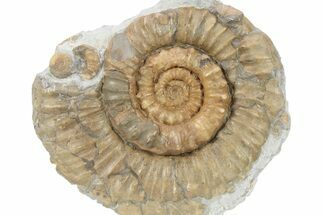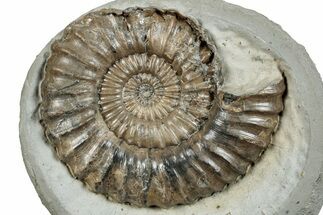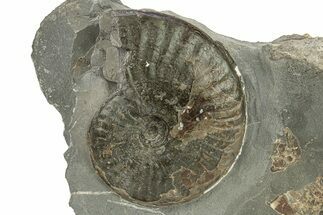This Specimen has been sold.
14" Ammonite (Paracoroniceras) Fossil - Dorset, England
This is a breathtaking specimen of the Lower Jurassic ammonite Paracoroniceras lyra, collected from Lyme Regis region of England. It's 14" wide and was originally found inside of a concretion that was almost completely prepped away. The display side of the ammonite has had the rock carefully removed and lightly polished while the reverse side still shows the surrounding concretion.
Comes with a metal display stand.
The center of the ammonite has been restored, as this area is frequently not well preserved on larger ammonites. There is some additional touchup restoration along the periphery of the ammonite.
Comes with a metal display stand.
The center of the ammonite has been restored, as this area is frequently not well preserved on larger ammonites. There is some additional touchup restoration along the periphery of the ammonite.
About Ammonites
Ammonites were ancient marine cephalopods, similar to today's squids and octopuses, but with a defining feature: their distinctive, tightly coiled spiral shells. These shells, resembling those of modern nautiluses, served as both a protective home and a buoyancy aid, allowing ammonites to navigate the prehistoric seas with ease. First emerging around 240 million years ago in the Triassic Period, ammonites thrived for over 175 million years, adapting through numerous forms and sizes. As predatory creatures, they likely fed on smaller marine organisms, using their tentacles to capture prey. However, their long reign came to an end 65 million years ago at the close of the Cretaceous, coinciding with the mass extinction event that also eliminated the dinosaurs.
Ammonites were ancient marine cephalopods, similar to today's squids and octopuses, but with a defining feature: their distinctive, tightly coiled spiral shells. These shells, resembling those of modern nautiluses, served as both a protective home and a buoyancy aid, allowing ammonites to navigate the prehistoric seas with ease. First emerging around 240 million years ago in the Triassic Period, ammonites thrived for over 175 million years, adapting through numerous forms and sizes. As predatory creatures, they likely fed on smaller marine organisms, using their tentacles to capture prey. However, their long reign came to an end 65 million years ago at the close of the Cretaceous, coinciding with the mass extinction event that also eliminated the dinosaurs.
SPECIES
Paracoroniceras lyra
LOCATION
Monmouth Beach, Lyme Regis, Dorset, England
FORMATION
Lower Lias, Bucklandi Zone
SIZE
14" across, 32 lbs.
CATEGORY
SUB CATEGORY
ITEM
#211932
We guarantee the authenticity of all of our specimens.
 Reviews
Reviews












